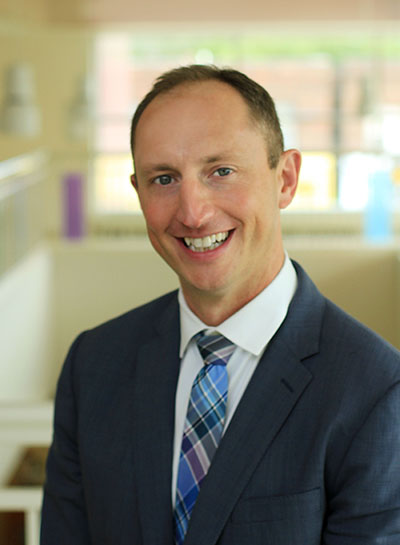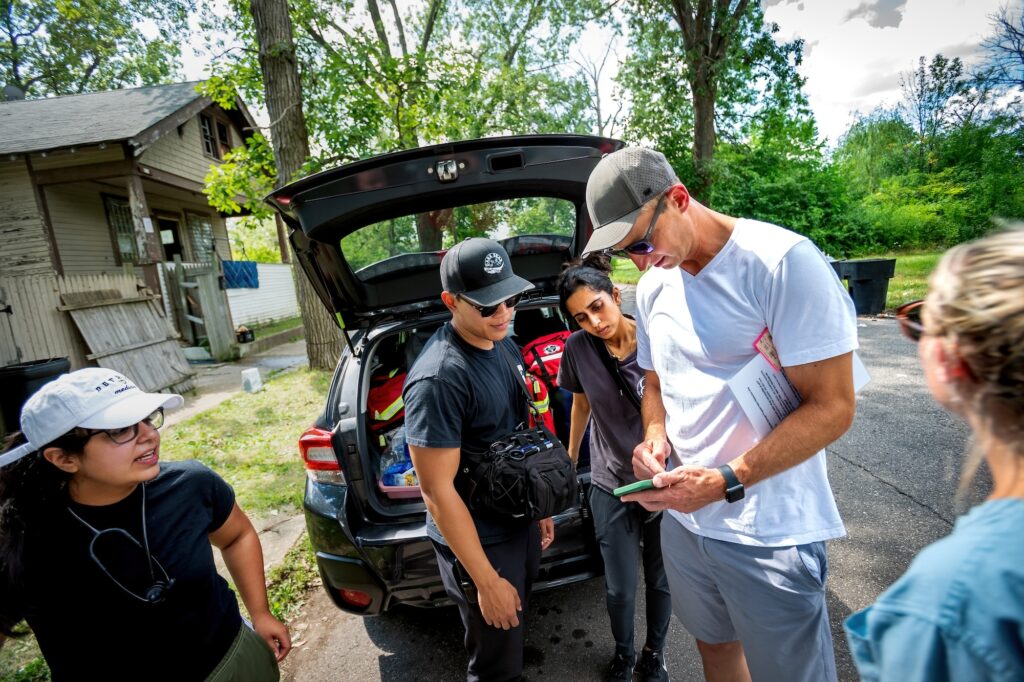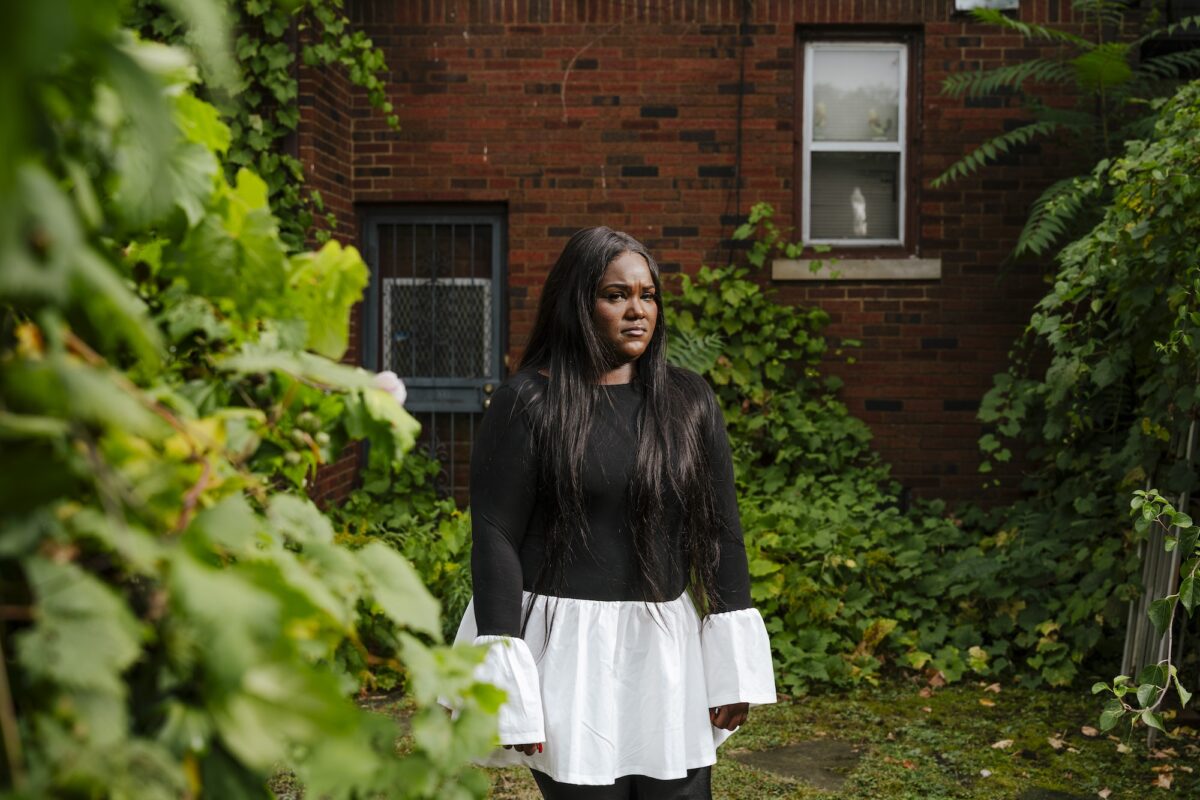This story was produced as a project for the USC Annenberg Center for Health Journalism’s National Fellowship, with support from the National Fellowship Fund and the Dennis A. Hunt Fund for Health Journalism.
In 2013, Deanne Austin bled for six weeks straight.
Before the incident, a physician diagnosed her with polycystic ovary syndrome, a hormonal disorder that intensifies menstrual symptoms. Her body ached from cramps and migraines.
“It can be very draining,” Austin, who lives in Detroit, said of her condition, which is manageable but has no cure.
This time, as the blood flowed, Austin struggled to breathe, which was troubling and strange. Worried, she wanted to act before her symptoms got worse.
But Austin, then in her 20s, faced restrictions in her travel options. She had no driver’s license— local highways with speeding cars daunted her. And calling an ambulance was out of the question – she had no health insurance.
Austin’s grandmother, Edythe Moore, saw signs of a health crisis. She feared for her grandchild’s life. Moore finally drove her to the emergency room, where Austin stayed overnight and received a blood transfusion.
“She was so scared. She didn’t want me to try to get on the bus,” Austin recalled.
Accessing health care – doctors’ appointments, the pharmacy or the ER – in a city and region that relies heavily on personal vehicles and invests far less in public transit than comparable cities, is an ongoing dilemma for Detroiters like Austin. In Detroit, 21% of households lack access to a car. Statewide, it’s 7 %.

In times of urgent medical need, residents without cars often struggle to reach care, navigating unstable circumstances. They’ll rely on loved ones for rides to doctors’ offices. They’ll pay for rideshares that strain their finances, or wait hours for a bus to transport them to specialists located far from home, if a bus arrives at all. They’ll walk for miles to retrieve medications.
A lack of access to a car can also result in them neglecting basic health maintenance, causing anxiety, stress and social isolation. Missed doctor’s appointments can lead to increased hospitalizations. Transportation insecurity related to healthcare access is also associated with a greater risk of death from chronic liver disease.
Richard Bryce, the chief medical officer at the Community Health and Social Services Center (CHASS) in southwest Detroit, said he wishes that public transit options were more dependable for his patients.
“It’s not like you’re going to go to just one place,” Bryce said of patients’ healthcare visits. “Often, there are multiple places that you have to go, which means that the complexity of the transportation needs to be supportive for that.”
“If you don’t have a car, that’s a problem.”
The stigma of being car-free
About 36% of city residents are transportation insecure, or unable to get to places in a safe and timely manner, due to a lack of resources, a 2025 University of Michigan report found.
It is a leading hardship known to patients, clinicians and government officials across the city that limits opportunities to live well and create community connections.
Without a car, Fallon Wilson’s world is full of calculations, mainly miles and money.
Wilson, a 43-year-old office assistant from Detroit’s east side, has ordered Uber or Lyft to take her teenage daughter to get check-ups and treatments for minor injuries from playing sports. To keep finances in check, Wilson must closely track her rideshare spending.
Living in a city built for cars, Wilson, who has anxiety, said she doesn’t drive because her brain “fizzles out.”
“Driving in traffic makes me extremely, extremely nervous,” Wilson said. She usually travels alone, afraid to ride the bus because of potential safety threats.
As a result, she’s stuck in a cycle of uncertainty.
“Everything I do in my life revolves around, ‘how am I going to get there?’ That creates anxiety in every facet of your life,” Wilson said. She remembers the stares she got from staff as she idled in a dentist’s lobby, waiting for a ride, flushed with embarrassment and self-consciousness over her predicament.
With limited income, Wilson tries to be a “fun” mother but can’t afford to pay for multiple rideshares to take her daughter to regular swim classes, the movies or the city’s downtown district. She’ll see other mothers pick up their daughters and drive them to the mall.
“I’m not in a position to do that,” Wilson said.
Wilson worries that her daughter, a cheerleader, volleyball player and only child, isn’t flourishing in ways she hopes for. Her daughter is still “a little sheltered,” she said, because of the family’s transportation status.
“It shames me as a mom,” Wilson said.
“I try to make sure that we have streaming services and snacks in the house, but she’s not getting out and socializing with other people her age.”
Miles away from a pharmacy
Transportation hardships in Detroit often burden the most vulnerable—young adults, older adults, disabled people, people with low incomes and people without jobs.
Some patients without stable housing “definitely walk far,” to different destinations, said Bryce, who is a faculty advisor and attending physician for Detroit Street Care, a student-run program at Michigan State’s College of Osteopathic Medicine. He oversees this program, along with Street Medicine Detroit at Wayne State University, which works closely with the CHASS street medicine team.
Bryce has seen unhoused patients develop calluses under their feet from walking, often lacking amenities needed for modern travel.
“They may not have a phone, let alone a car,” Bryce said.

On any given night, more than 1,700 people in the city are living on the street or in places unfit for human habitation, while others find temporary relief in shelters or transitional housing. Homelessness is often associated with malnutrition, parasitic infestations and other serious diseases. Getting treatment can be “virtually impossible” for those impacted.
Street medicine teams try to solve this problem by going to the people. They provide primary and preventative care to unhoused residents on the streets or in shelters, forging relationships built on dignity and respect. Still, less-resourced patients often face tough journeys to care.
“They’ll go to the hospital, and then the hospital will send a prescription, like a mile or two away to a different pharmacy,” Bryce said, noting that the barriers may be too much for those enduring poverty and a lack of transportation access.
“These are things that we need to do better as a health system to anticipate.”
Painful commutes with chronic conditions
About 20 years ago, Michael “Brother” Cunningham, a transit activist, would board buses to suburbs like Warren and Clinton Township for appointments with pain specialists. It was a rough time.
Cunningham suspects his grueling work as a meat cutter at a Farmer Jack grocery store led to his herniated disc and polyradiculopathy, a neurological condition characterized by nerve pain and weakness. He uses a quad cane sling chair to walk around.
Waiting for the bus, he said, was physically “unbearable.”
“I would have to take two or three buses,” Cunningham said. “Anytime I took the bus, climbing on, climbing off, [it was] painful. I walk around in pain, pain, pain, and more pain. It’s a sharp pain shooting down the legs to the feet. That’s called sciatica.”
About 20 years later, Cunningham, now 43, works as a taxi cab driver. He’ll also cruise around Detroit’s neighborhoods, passing out bus cards and urging folks who need it to use the city’s paratransit services. Residents in need of rides can call Cunningham at 313-444-9114.
Some city buses still leave riders waiting. In October, 80% of daytime buses left terminals on time, compared to 63% in the late afternoon and evening, according to the Detroit Department of Transportation (DDOT)’s performance dashboard. With a $20 million budget increase, DDOT, the city’s largest public transit provider, aims to hire more drivers and mechanics, replace bus shelters and implement other measures to improve performance.
Long, painful bus commutes pushed Cunningham to advocate for better public transit in Detroit. He recently organized ride-alongs on local buses for the city’s leaders to highlight flaws in the system.
“I get the city council and the mayor, candidates and incumbents to get on the bus, and I do that, but I’m in pain when I do,” he said.
A long distance is a maternal health obstacle
Bryce remembers one street medicine patient who became pregnant.
The expectant mother needed to visit the clinic once a month. Early on, the trip was manageable for her. But as the trimesters progressed and her belly grew, she had to come to CHASS every two weeks, Bryce recalled. The clinic was a few miles from where she stayed, but the distance was an impediment. She could no longer make multiple trips on her own. Aware of the pregnant mother’s hardship, the clinic’s staff realized she could miss appointments.
Skipping prenatal care can threaten the health of a pregnant person and an unborn baby.
Doctors can’t catch early signs of fetal distress or abnormal development. Untreated conditions like high blood pressure or diabetes can increase the risk of preeclampsia, a pregnancy complication that can be fatal, gestational diabetes, or pre-term birth.
In 2023, 15.6% of Detroit babies were born prematurely, and pre-term births were highest among Black babies at 16.3%, according to a March of Dimes analysis. In that year, Michigan’s pre-term birth rate was 10.3%.
The staff and the woman made an informal pact. She’d come to the clinic once a month, and other times, staff would go to her.
“We’d go see her on the street,” Bryce said. “Check her blood pressure and listen to the baby’s heartbeat, which we did.”
Multiple doctors and expensive rides
Austin’s grandmother, Edythe Moore, died in 2023. Her death meant a loss of support for Austin.
Moore had championed her granddaughter’s health at every turn, Austin recalled. She urged Austin to follow a disciplined regimen of diet and exercise. She drove her to prediabetic classes in addition to doctor’s appointments. Austin said she never missed a session because of her.
Now 39, Austin has had a fulfilling adulthood as a political organizer for mothers of color. But a new health problem has emerged: Anemia.
Anemia has caused Austin’s blood pressure to rise and her heart to pound and race. Earlier this year, Austin received six weeks of iron infusions to replenish her mineral levels.
To help manage her condition, Austin consults a long list of doctors, several of them headquartered in the suburbs.
“I have to go see a cardiologist. I have a rheumatologist dealing with this anemia. I have a hematologist,” she said. Her primary care physician is in Redford and recently referred her to a gastrologist to monitor her stomach inflammation.
Despite pressure from family members, Austin still doesn’t drive. She can’t imagine herself on the road when the blood disorder saps her energy. She’ll take Uber and Lyft to go see her doctors. Each one-way rideshare trip costs at least $25, she said, but surge pricing during peak times could raise the price to $50.
Her healthcare bills are piling up too, which aggravates her anxiety even more.
“It’s super hard. I am not married. I don’t have kids yet, so I’m, like, my sole provider,” Austin said. “I feel like I can’t get ahead.”


